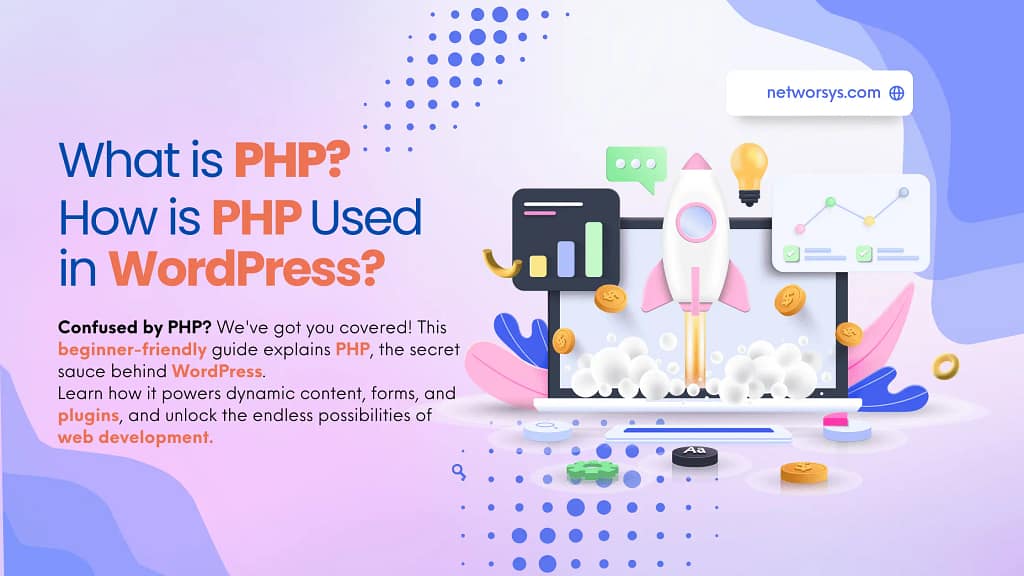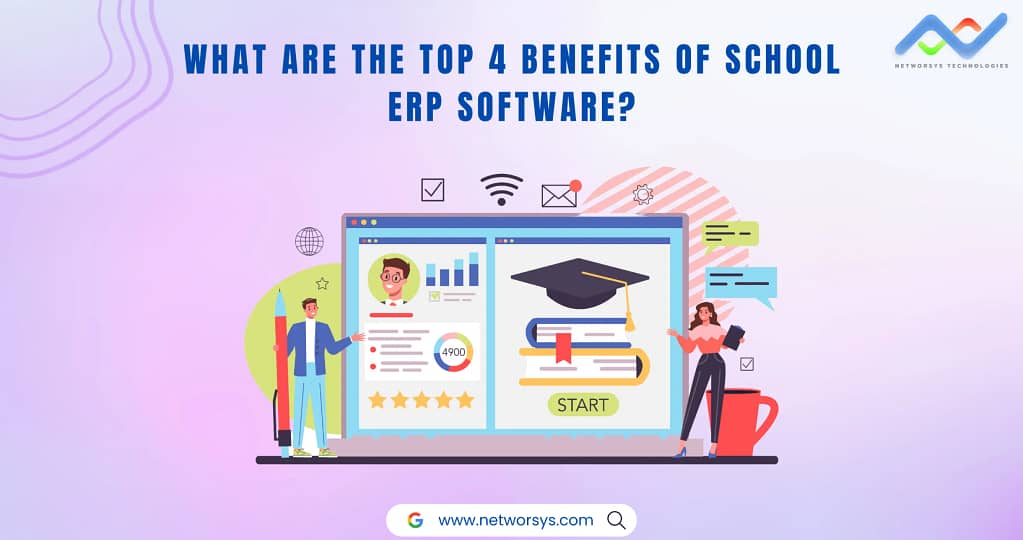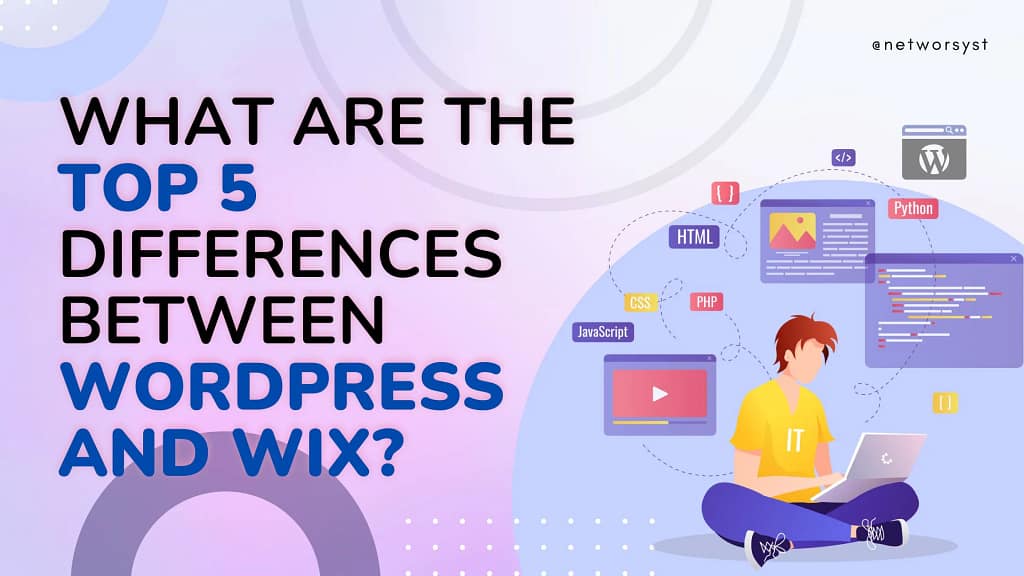Table of Contents
ToggleEver wondered how dynamic websites tick? The secret sauce in many is PHP, a powerful scripting language that brings your online experiences to life!
In the internet world, where static content once dominated the whole market, dynamic websites have emerged as solid competition, taking away all the attention of users with interactive features and real-time updates!
Behind the scenes of this dynamic web lies PHP, an acronym that not only stands for “Hypertext Preprocessor” but also serves as the heartbeat of countless websites, making them come alive with functionality and interactivity.
It was developed in 1994 by Rasmus Lerdorf.
According to W3Techs, as of January 2024, 76.6% of all websites whose server-side programming language is known use PHP.
This means that nearly 4 out of every 5 websites include PHP to some extent.
In the rapidly changing world of the internet, where user expectations constantly evolve, PHP is proof of adaptability and longevity.
From its simple-humble beginnings as a personal project to becoming the base of web development, PHP has played a central role in shaping the interactive, data-driven websites we operate daily.
As developers continue to explore new limits, the legacy of PHP remains, reminding us that the power to create responsive websites often lies in the hands of a scripting language that started with a simple desire to track online visits.
So, the next time you are amazed at the beautiful features of a website, remember that behind the scenes, PHP is the hero.
Features of PHP for WordPress-
Server-side scripting-
At the core of PHP’s skills is its server-side scripting capability. This means the PHP code executes on the server before reaching the users’ browsers.
This processing allows WordPress to generate personalized content, handle user inputs, and interact with databases, all before the final web page reaches the user.
Versatility-
PHP is capable of making both simple scripts and complex applications.
Whether implementing basic functionalities or developing complex features for your WordPress site, PHP’s adaptability ensures a smooth and efficient development process.
Easy to learn-
PHP strikes a balance between simplicity and power. It’s designed to be user-friendly, making it accessible to beginners, yet it also has the capabilities needed for advanced functionalities.
As you start your WordPress journey, PHP offers a gentle learning curve without compromising on the potential for creating sophisticated web solutions.
Reasons Why PHP is Used in WordPress
Open-source and Community Support
- PHP is like a free-to-use language. It lets anyone see and modify its code, and an extensive community of developers is there to help.
- With WordPress being PHP-powered, it’s like having a giant team of friends who share tips, fixes, and cool ideas.
Efficient Handling of Dynamic Content
- It handles real-time stuff like comments, updates, and personalized content without hiccups.
- PHP is behind the scenes when you click something on a WordPress site, making it happen quickly and smoothly.
Smooth Integration with Technologies
- PHP is like a translator that quickly speaks the languages of the web – HTML for structure, CSS for style, and JavaScript for making it all interactive.
- This means your WordPress site can be a beautiful collaboration of different skills, creating a stunning and functional online space.
Flexibility for Customization
- PHP is not rigid but a flexible tool belt for developers. It lets them shape and mold WordPress according to specific needs.
- Want a unique theme or a custom feature? PHP allows developers to bring creative ideas to life, giving your WordPress site a personal touch.
Security and Stability
- It follows best practices, providing a secure content and user data environment.
- The stability of PHP means your site is less likely to face crashes or unexpected glitches, ensuring a smooth and reliable user experience.
How PHP Powers WordPress- A Simple Breakdown
WordPress relies heavily on PHP for its good parts. Let’s break down how PHP is crucial in making WordPress work fluidly, covering core functions, themes, plugins, and custom modifications.
PHP Core Processing-
PHP is like the engine running inside WordPress. When someone visits your site, PHP kicks into action, fetching data from the database and putting together the web page you see.
Example: Imagine your blog page magically updating with the latest posts whenever someone opens it. That’s PHP in action.
PHP in Theme Development-
Themes decide how your site looks. PHP is the tool we use to make these themes. It helps us add dynamic elements, control layouts, and make your site visually appealing.
Example: The PHP in a theme can make each post look unique by showing the author’s name, post date, and category.
PHP in Plugins-
Plugins give your WordPress site extraordinary powers and features. We use PHP to create these plugins, adding cool features without messing up the central WordPress system.
PHP for Custom Stuff-
When your site needs something special, PHP steps in. Whether it’s a new feature, a custom form, or a unique page style, PHP helps us make WordPress fit your needs.
Example: PHP can make it happen if you want a special section on your site that shows products based on what users like.
Advanced Uses of PHP for WordPress
Object-Oriented Programming (OOP): Building with Structure
Object-oriented programming (OOP) is like organizing code into neat, reusable building blocks.
Instead of a chaotic assembly, OOP introduces classes and objects, making your code more organized and efficient.
In PHP for WordPress:
OOP helps organize your code by grouping related tasks together.
Instead of scattering code for different elements, like posts and comments, all over the place, OOP lets you neatly organize them within specific classes, making your codebase cleaner and more maintainable.
Security Considerations-
When it comes to the web, security is essential. Understanding and implementing security measures in PHP ensures your WordPress site is resilient against potential threats.
In PHP for WordPress-
Security in PHP involves protecting your site from malicious attacks. This includes validating and sanitizing user inputs, protecting against SQL injection, and securing sensitive data.
Imagine someone trying to sneak harmful code into a form on your site. With proper security measures in PHP, the code checks and ensures only safe inputs get through, keeping your site secure.
Modernizing with Roots Stack: Better efficiency and performance.
The Roots Stack is a dominant toolkit for modern WordPress development. It brings tools like Bedrock for project structure, Sage for theme development, and Trellis for server management, aligning your workflow and increasing performance.
In PHP for WordPress-
The Roots Stack modernizes how you build and manage WordPress. It introduces a cleaner project structure, better theme development practices, and efficient server management for improved speed and performance.
Instead of a messy file structure, Roots Stack logically organizes your project. It’s like having a well-organized toolbox where you can quickly find the right tool for the job.
What are the latest trends and updates in PHP that developers should be aware of?
Continued Focus on Performance and Security-
- PHP 8.2 introduced performance improvements like read-only classes, null, accurate, and false as stand-alone types, and optimized JIT compilation.
- PHP 8.3, expected in November 2023, will bring further performance enhancements with features like randomizer add-ons, json_validate, and improved unserialize() error handling.
- Security measures like type hinting and deprecation of unsafe functions are being emphasized.
Rise of Cloud-Integrated Development-
- Frameworks like Laravel and Symfony offer seamless cloud integration, allowing developers to build scalable and cost-effective web applications.
- Platforms like AWS Amplify and Google Cloud Run simplify deployment and server management for PHP applications.
User Interface Trends-
- Responsive web design remains crucial, and PHP frameworks are adapting with features like server-side rendering for optimal mobile experiences.
- Single-page applications (SPAs) are gaining traction, and PHP frameworks like Laravel Livewire enable efficient SPA development.
Integration with Emerging Technologies-
- Internet of Things (IoT): PHP frameworks are well-suited for building IoT applications, connecting devices, and handling data streams.
- Blockchain: Developers are exploring the potential of PHP for blockchain-based applications in areas like supply chain management and decentralized finance.
- AI and Machine Learning: Frameworks like TensorFlow offer PHP libraries for integrating AI and ML capabilities into web applications.
Focus on Developer Experience-
- Tools like static code analysis and type checking improve code quality and reduce errors.
- Improved documentation and developer communities make it easier for newcomers to learn and contribute to PHP projects.
Implications for WordPress Development-
- Many trends directly impact WordPress development, as plugins and themes are often built with PHP.
- Staying updated with the latest PHP versions and framework advancements ensures performance, security, and compatibility for WordPress projects.
- Cloud-based hosting and serverless functions can optimize WordPress deployments and scalability.
- Integrating new technologies like AI and IoT opens up exciting possibilities for WordPress-powered applications.
Want a highly immersive and user friendly website?
Some tools and frameworks that complement PHP in WordPress development, along with links-
Version Control Systems-
Git- Essential for tracking code changes, collaboration, and managing different versions of your WordPress project.
Dependency Managers-
Composer- Manages PHP dependencies, ensuring consistency and avoiding conflicts.
PHP Frameworks
Laravel- A powerful and versatile framework with features like routing, templating, authentication, and object-relational mapping (ORM).
Symfony- A mature and well-respected framework known for its flexibility and modularity.
Testing Frameworks-
PHPUnit is an industry-standard testing framework for PHP, ensuring code quality and reliability.
Debugging Tools-
Xdebug– A debugger for PHP that allows you to step through code, inspect variables, and identify errors.
Code Linting and Formatting-
PHP_CodeSniffer– Enforces coding standards and catches potential errors.
PHP CS Fixer- Automatically formats PHP code to adhere to style guidelines.
Security Tools-
WordPress Security Scanner- Scans your WordPress installation for vulnerabilities.
Performance Optimization-
Blackfire.io- Profiles PHP applications to identify performance bottlenecks.
API Development
REST API frameworks- Facilitate the creation of RESTful APIs within WordPress, such as:
Front-End Development-
JavaScript frameworks- Enhance user experience and interactivity:
Package Managers-
npm: Manages front-end dependencies and assets for WordPress themes and plugins.
How does PHP contribute to a WordPress site’s overall speed and responsiveness?
PHP plays a crucial role in contributing to the speed and responsiveness of a WordPress site through several mechanisms-
Server-Side Scripting Efficiency-
PHP is a server-side scripting language that processes and executes code on the server before sending the finalized HTML to the user’s browser. This server-side execution minimizes the processing required by the user’s device, enhancing overall speed.
Caching Strategies-
PHP allows developers to implement caching strategies to store previously generated HTML content. By caching pages, PHP reduces the need to regenerate content for each user request, leading to faster page load times.
Database Interactions-
WordPress heavily relies on databases to store and retrieve content. PHP efficiently handles database interactions, optimizing queries and ensuring quick access to information. Efficient database management contributes to faster content retrieval and rendering.
Asynchronous Processing-
PHP supports asynchronous processing, enabling specific tasks to run in the background without affecting the user experience. Asynchronous operations, such as handling background tasks or sending emails, prevent delays in page loading and enhance overall responsiveness.
Optimized Code Execution-
PHP allows developers to write optimized code that follows best practices. Well-structured and efficient PHP code ensures that the server processes tasks quickly, reducing the time it takes to generate and deliver the final HTML output.
Integration with Content Delivery Networks (CDNs)-
PHP integrates with CDNs and distributed network servers that cache static content like images and stylesheets. PHP reduces latency and faster content delivery by offloading fixed assets to CDN servers closer to the user.
Dynamic Content Generation-
PHP excels in dynamically generating content based on user interactions, preferences, or real-time data. This dynamic content generation ensures users receive personalized and up-to-date information, enhancing the overall user experience.
Resource Optimization-
PHP provides features for resource optimization, such as memory management and garbage collection. Efficient resource usage contributes to a more stable and responsive WordPress site.
Integration with Opcode Caching-
Opcode caching is a PHP optimization technique that stores compiled PHP code in memory, reducing the need to recompile code on each request. This accelerates the execution of PHP scripts and significantly improves the speed of WordPress sites.
Support for Asynchronous Tasks and Multithreading-
PHP supports asynchronous programming and multithreading, allowing developers to handle concurrent tasks efficiently. This capability is particularly beneficial for functions performed in the background, contributing to a more responsive user experience.
CONCLUSION-
PHP powers the heart of the web, and WordPress is no exception. From simple blog posts to applications, PHP breathes life into WordPress, making it the versatile and powerful platform it is today.
Whether you’re a developer building custom features or a user seeking a dynamic website, understanding PHP’s role in WordPress HELPS you to appreciate its capabilities and utilize its potential.
Key Takeaways-
- PHP’s vital role in WordPress functionality, from core processing to theme development and plugin creation.
- PHP’s adaptability allows developers to tailor WordPress, whether a unique theme or a custom feature, to your needs.
- PHP focuses on optimized code execution, caching strategies, and secure data handling, ensuring a smooth and reliable WordPress experience.
- The latest trends in PHP, like object-oriented programming, security advancements, and cloud integration, shape WordPress development’s future.
- As a developer, utilize the tools and frameworks to build sophisticated and efficient WordPress applications.
Frequently Asked Questions (FaQ)
Why do you need PHP for WordPress?
PHP is the scripting language that powers WordPress, handles dynamic content and database interactions, and enables the platform’s functionality.
Is WordPress + PHP still 'the way' to make sites?
WordPress with PHP remains a popular and effective way to create websites, offering flexibility, scalability, and a vast community of developers.
What is PHP, and why is it needed to create a website?
PHP is a server-side scripting language crucial for dynamic web development. It’s needed to process forms, interact with databases, and create dynamic website content.
Can we convert a WordPress website to PHP?
WordPress itself is built with PHP. If you mean moving away from WordPress, a manual conversion is possible, but it’s complex due to architectural differences.
Do WordPress developers need to know PHP?
Understanding PHP is essential for WordPress developers as it empowers them to customize themes and plugins and troubleshoot issues effectively.
How do I work in WordPress with PHP code?
To work with PHP in WordPress, access the theme files, customize functions.php, or create custom templates. Familiarity with WordPress hooks and APIs is crucial.
Which part of a website is made in PHP?
PHP is responsible for server-side logic, handling tasks like processing forms and interacting with databases to generate dynamic website content users see.
Which is better, PHP or WordPress, in 2024?
Comparing PHP and WordPress is like comparing apples to oranges; PHP is a programming language, while WordPress is a content management system built with PHP. They complement each other for web development.
Which is easier, PHP or WordPress?
WordPress is designed to be user-friendly, making it easier for beginners to create websites. PHP, being a programming language, has a steeper learning curve.
Why is PHP a better option for website development?
PHP is versatile, supports various databases, and is widely used for server-side scripting, making it a robust choice for web development, including building dynamic websites.
WordPress and PHP or PHP & Python only?
WordPress is built with PHP. PHP and Python serve different purposes; PHP is standard for web development, while Python is versatile and used for various applications.
How can I write my PHP code on a WordPress page?
Use custom fields, shortcodes, or the theme’s template files to securely insert PHP code into WordPress pages.
What is the best way to practice PHP for WordPress?
Practice creating custom WordPress themes or plugins, modifying existing ones, and exploring PHP functions related to WordPress development.
Can you use JavaScript instead of PHP on a WordPress site?
While JavaScript enhances interactivity on the client side, PHP remains crucial for server-side tasks in WordPress, and both are often used together.
What is WordPress? Is it a programming language?
WordPress is not a programming language; it’s a content management system (CMS) written in PHP, simplifying website creation and management.
What types of websites can be developed using PHP?
PHP can be used for various websites, from simple blogs to complex e-commerce platforms, due to its ability to handle server-side scripting and database interactions.
How can you tell if a website is using PHP or not?
Check the file extensions; if you see “.php” in the URLs or inspect the page source code, you can often find PHP code embedded in the HTML.
Which one is better, WordPress or Simple PHP?
The choice depends on the project requirements. WordPress is user-friendly for content management, while Simple PHP provides more control for custom, complex solutions.
Which is faster, PHP or WordPress?
This comparison is not accurate since PHP and WordPress serve different roles. PHP is a scripting language, while WordPress is a CMS built with PHP. Their speed depends on various factors like server configurations and optimization.
Can we use WordPress with WAMP or LAMP servers?
Yes, WordPress is compatible with both WAMP (Windows, Apache, MySQL, PHP) and LAMP (Linux, Apache, MySQL, PHP) server environments, providing flexibility in hosting options.
Is it necessary to use JavaScript for a PHP website?
While not necessary, JavaScript enhances user interactivity on the client side, complementing PHP’s server-side functionality. Combining both languages can create a dynamic and responsive web experience.




Pingback: What is PHP? How is PHP Used in WordPress? - Amazing News USA
Pingback: What is PHP? How is PHP Used in WordPress? - Business Market News
Pingback: What is PHP? Exploring Its Role in WordPress Development - Premium Business News